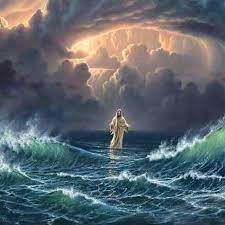
The Reasons Jesus Walked Upon Water Revealed
SUMMARY
Jesus left Capernaum and sailed east to Bethsaida for a brief political asylum. There He preached, healed and fed ten thousand people. As the sun was setting, He told His disciples to sail back to Capernaum and He would meet up with them later. Jesus then went up in the mountains to pray. The disciples set sail, but a great storm came off the Mediterranean blowing the ship in the opposite direction. God did not cause the storm, but He would use it to test the faith of the disciples. The disciples decide to row the ship, but the storm pushed the vessel in every direction but home. By four o'clock in the morning, the storm had become so great that the disciples feared for their lives. It was then Jesus looked out onto the Sea and spotted them. He knew they were in trouble and were so focused on saving themselves that they forgot to rely on Him. So, He walked out to them upon the Sea. The disciples saw Him but mistook Him for the ghost of a drowned sailor. This vison was thought to be an omen of impending death. The disciples shrieked in horror, but still no shout out to Jesus. Jesus quickly approached the disciples and assured them He would not let them be harmed. Peter then asked if he could walk out to Jesus. Jesus said, "Come!" and Peter climbed out of the ship. But as he walked on the water to Jesus, he looked down at the turbulent Sea, heard the roar of the winds and became sacred. It was then that he started to sink. He cried out to Jesus to help Him. Jesus reached out and grabbed his hand. Immediately Peter was again above the waves. Jesus then questioned why he had shown such little faith in Him. As they boarded the ship, the storm instantly stopped. The disciples then fell at Jesus' feet and worshipped Him as the Son of God. At this same moment, the sun rose and the ship was somehow safely docked at the very place Jesus had intended to visit that day. The story shows us that to rely on Jesus insures safety. Also, Jesus has the power to control any and all events including the ability to bend the laws of nature to His will. He even has the power to manipulate time and space in that the ship went from being in the middle of the Sea to being safely docked in only seconds. All of these powers displayed during this event serve to support His promise concerning the Resurrection and Rapture.
THE DEEP DIVE

This story starts with the beheading of John the Baptist by Herod Antipas, a son of Herod the Great. Jesus no doubt knew the fate of John just as He publicly stated how He and Peter would die. The famous Jewish historian Josephus tells us that John's corpse was thrown out of the prison and onto the ground. If it was not claimed after a few days by family or friends, it would have been burned in the city dump or possibly buried in the city‘s indigent burial ground also known as a Potter's Field. But in this case, John's disciples retrieved the body and gave it a traditional Jewish burial. Thus the life of the last Jewish Old Testament prophet came to an end. And like most Jewish prophets, he was also rejected by the majority of his people and executed. However, because he was given the honor of officially announcing the arrival of the long awaited Messiah, he is considered as the greatest and last of the prophets (Matthew 11: 9-11).
Jesus knew of John's beheading before the disciples came to Him with the news just as He knew Lazarus had died before the messenger met with Him. Jesus understood that John had completed his mission in announcing the start of Jesus' ministry {"the Kingdom is at hand"} and was destined to be martyred. John was now speaking truth to power from prison, so his execution came as no surprise to Jesus (Matthew 20:22-23; John 3:30). But Jesus was concerned about the immediate effects this event would have on the general public and the country's civil and religious leaders. While Jesus mourned the loss of John, He also celebrated his life as he knew he had accomplished his mission and that his intelligent spirit was now resting in Sheol. There it was awaiting to be released on Resurrection Sunday (Luke 7:28; Mathew 27;52-53; Ephesians 4:8). However, Jesus was determined to continue His forty month ministry just as he knew John would have wanted Him to do. Therefore, He decided, for three reasons, to take His disciples east across the Sea of Galilee.
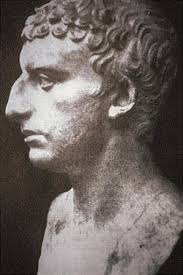
First, Capernaum and the Galilee region was controlled by Herod's son Herod Antipas who had John beheaded as a gift to his step daughter.

However, the city of Bethsaida was controlled by Herod's other son Philip the Tetrarch. So it was prudent for Jesus to go there and continue to preach and heal until it was deemed safe for Him to return to the Galilee.
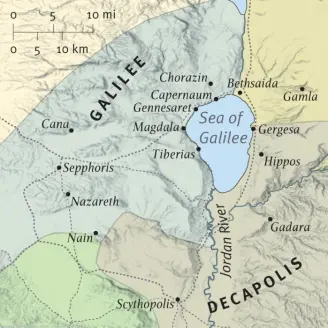
His second reason was that Capernaum had once again become overwhelmed by the crowds streaming in to meet, hear and be healed by the great Rabbi Jesus. While the multitudes were an economic boon for some in the city, they were also a problem concerning crowd control and the quality of life for residents. And finally, the disciples occasionally needed a little R&R. Some of the disciples were married while others like Peter were still running a business. So Jesus always included in His itinerary time for them to rest, relax and converse.
Jesus commanded His disciples to board one of Peter's fishing ships and sail from His home in Capernaum to Bethsaida. In this way, He would draw the crowds away from the City of Capernaum to the countryside of Bethsaida only six miles to the northeast. There He would preach, heal, send the crowds home, and then enjoy some down time with His disciples. Jesus publicly boarded a ship and set sail, drawing the crowds into a nearby large open grazing field. Thus, the crowds of Capernaum simply followed the ship walking along the road that surrounded the Sea. And along the way, more and more people joined the crowds. So, when Jesus landed, a crowd of five thousand men and perhaps an additional ten thousand women and children were there to greet Him. Jesus stared out at the sea of poor and sick people looking like lost sheep and had compassion on them (Matthew 9:36). He not only taught and healed them, He also fed them. Please see related: "Why Jesus Fed 5,000 Then Asks For the Leftovers Back".
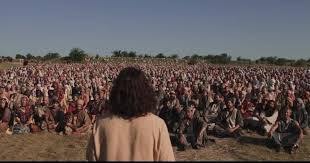
Now it was time for Jesus and His disciples to take a short respite. But this was not to be. It was right after the crowd was fed that certain men who had witnessed the miracle came to understand that Jesus must be the prophet- messiah that Moses prophesied would come after him (Deuteronomy 18:15). So, they decided that they would start declaring him as such and would take him, by force if necessary, to Jerusalem and crown him as King. Jesus, reading their minds, put a plan into action. As the sun was setting, Jesus told His disciples to immediately go down to the shore and leave Bethsaida sailing back to Capernaum. He tells them He will catch up with them later. Meanwhile, Jesus would meet with late comers then quietly disappear by climbing up into the mountains. In this way He escaped the plan of the men to take Him by force to Jerusalem. They assumed He was on the boat with the disciples but in fact was now alone and could pray, and recharge both mentally and physically (Matthew 14:22-23; Mark 6:45-47; John 6:14-17).
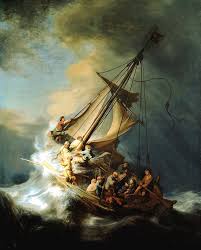
As the disciples boarded the ship, the winds were picking up and dark clouds were quickly rolling in from the west. Still, the trip was only six miles southwest and the disciples knew they could easily row that far if need be. The disciples were expecting to be back home in Capernaum within the hour. However, the storm was somewhat unusual as it was coming out of the west off the Mediterranean Sea full of rain heavy clouds and blowing strong winds in the direction of the northeast. This was the exact opposite direction the disciples needed to go. It was now night time and the storm had intensified with gale winds and rough seas. Peter took the ship's sails down and the disciples were now rowing. They would row over three miles, but it was no use as the ship was now completely controlled by the ever changing direction of the winds (Matthew 14:24; John 6:18-19). The disciples were hopelessly stuck in the middle of a raging storm, in the middle of the night, in the middle of a treacherous sea that was over two hundred feet deep. By the time of the Fourth Watch {3:00am - 6:00am}, the disciples were physically and mentally exhausted. They were now thinking the boat would eventually be swamped by the large rolling waves and sink. In that case, some if not all, would drown (Matthew 14:25). Interestingly, this time frame is the exact same time that God parted the Red Sea so that the Israelites could escape the army of Pharaoh (Exodus 14:24).
It was now, in the darkest hour of the night and the darkest hour of despair for the disciples, that Jesus looks out across the water. Scripture tells us Jesus "saw the disciples struggling" in their efforts to keep the ship from being capsized. The fact that Jesus, standing on the shore, can clearly see them many miles out to sea, what they are doing and their state of exhaustion and frustration is a miracle unto itself. The disciples would have been seated on small rowing seats facing the back of the ship. Jesus decided it was time to end the impromptu test and both reprove and strengthen their faith in Him in a decidedly dramatic and supernatural way. So, led by the Holy Spirit, Jesus began to walk or stride out to the ship in the storm. He would now create a miracle that would be faith affirming for not only His disciples, but for generations of Christians to come.
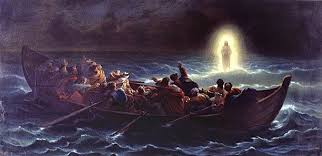
As Jesus approached the ship, all the disciples looked up and saw in the distance, the vaporous image of a man "walking upon the Sea". He was walking both towards them but also as if he would be passing them (Matthew 14:25-26; Mark 6:48; John 6:19). There are now two events taking place.
Jesus had apparently decided to cut short the walk from Bethsaida back to Capernaum by not walking around the Sea of Galilee. Instead He would walk directly across the sea as the crow flies. But in doing so, He was quickly walking west while the disciples were quickly being blown east. Therefore, He both appeared and then came up on them very quickly. Secondly, Jesus is described as seeming to be passing them but stops, looks at them and casually says, No need to scream, it’s Me. Further, Scripture does not say Jesus was walking in or on the water. It states He was "walking upon the sea". This phrasing would help explain how water could support a person. As it turns out, it did not need to as Jesus was most probably suspended slightly above the water and not actually touching it. In other words, the waves were rough and there was chaos because of the storm. But, Jesus was slightly above the waves serene and unencumbered by the weather conditions under His feet.
So why did the disciples see Him and start screaming in fear? Initially His distant vaporous visage was the sight the disciples and all sailors dreaded to see. Every first century Waterman knew that to see the ghost of a dead seaman was an omen that their own death was imminent. The disciples could not make out at this time that it was in fact Jesus because His image was distant and seen through the spray of wind tossed waves and rain. So, they instead assumed it was the spirit of death coming quickly at them and complete pandemonium ensued. No doubt some on the ship considered jumping overboard. However, as Jesus quickly grew closer, He could now be heard calling out to them in a cheerful voice saying, "Be happy because it is Me.. so there is no need to be afraid." (Matthew 14:27; Mark 6:50; John 6:20; Job 9:8; Job 38:16)
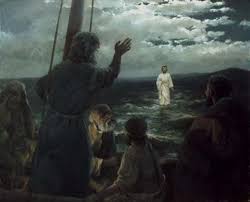
Nerves were now calmed and replaced by sheer awe at the sight of Jesus standing outside the ship. Peter immediately called out to Jesus and said, "Since it is You, let me come to You on the water." (Matthew 14:28) Jesus simply responded, "Come!" So Peter climbed down out of the ship and began walking on the water towards Jesus (Matthew 14:29). However, when he heard the wails of the wind, felt the pelting rain on his face and saw the flashes of lightening and peal of the thunder, he became scared. He must now have thought himself a fool to think that just by seeing Jesus, he too could actually walk on water. Fear is the direct result of a lack of faith. So, as Peter's faith slowly began to fade, his fear slowly began to grow, and he slowly began to sink. It was then he went into panic mode and screamed, "Lord, save me!" (Matthew 14:30).
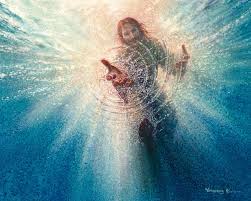
Immediately Jesus stretched out His hand and grabbed him saying, "O you of little faith. Why did you doubt?" what you could have accomplished through Me in faith (Matthew 14: 31). Jesus knew why Peter began to sink, but He wanted Peter to think it through. Peter took his mind off of Jesus and instead refocused on the tribulations of the world around him. He lost faith in Jesus' abilities and instead relied in his own abilities. And since he knew that he could not physiologically walk on water, this understanding became his new truth and so he sank. Jesus grabbed Peters hand but did not pull him up from the sea. Instead, He grabbed Peter's hand and willed that Peter be allowed to walk on the water. It was then the power of the Holy Spirit lifted Peter up and supported him as they walked back to the ship together.

At the Rapture, Jesus will once again command the Holy Spirit to do the heavy lifting. Only this time the Holy Spirit will lift billions of people up into the air. It will be the greatest miracle ever performed second only to the Big Bang and the creation of all things physical.
The two men reached the ship and climbed aboard. Immediately the storm ended. It stopped so fast that the ship went from wildly rolling in the waves to a dead standstill within seconds. It was then that every one on the ship came to Jesus and worshipped Him saying, "It is a truth, You 'are' the Son of God!" (Matthew 14:32-33; Mark 6:51; John 6:21). Here was a clear undeniable miracle, witnessed by all of them, that could not be rationally explained. But just wait until they witness the Resurrection!
On an interesting note, John adds yet another miracle to this story that few recognize. Jesus came aboard the ship, the storm calmed and the disciples worshipped Him. But John adds that, at that same time, the boat immediately came to rest on the shore where Jesus wanted to visit next. This means that Jesus got in the boat, the storm ended and they turned and found themselves docked safely on the other side of the sea. This miracle required Jesus to once again manipulate time and space. He had done this earlier when He turned water to wine at a wedding and then aged it.

The ship had landed just south of Capernaum at sunrise. From there they walked a few miles inland to the Land of Gennesaret. This village is often mistaken as being the town of Gerasene where Jesus performed the Miracle of the Swine. Please see related: "Jesus the Demon Hunter". Gerasene has been excavated and is located directly east of Capernaum on the opposite side of the Sea of Galilee (Mark 6:33).
QUESTIONS:
Did Jesus know that the crowds would follow Him to Bethsaida? Yes, and He moved ten thousand plus people out of Capernaum in only minutes so the people living there could have some peace and quiet.
Did He know He would need to feed these people? Yes, and He wanted all ten thousand plus to witness this miracle occurring in their own hands. Please see related : "Jesus Feeds five Thousand Then Asks for Leftovers Back".
Did He or Satan create the storm? No, Satan cannot create, he can only imitate within the boundaries God has set for him. The storm was just a natural weather pattern that Israel still occasionally experiences to this day.
Did He use the storm to teach a lesson? Yes, He wanted His disciples to witness His powers over nature. He also used the storm to test how His disciples would react under pressure. Then as now, God still does not create bad situations for people. However, He does use them to test and strengthen a persons faith. Life is for learning and a training ground for a believer's governing skills in order to actively govern with Christ in the Ages to come. Thus, the secret of life is not simply enjoying the passage of time. The secret of life is spiritual growth.
Why did the disciples have such a hard time understanding who Jesus was? First, Jesus never stated publicly or privately that He was the Messiah. Of course He was obviously the Messiah, but He wanted people to hear Him, watch Him perform miracles and come to their own conclusions. He did tell the gentile woman at the well He was the Messiah (John 4:25-26). And He did tell the High Priest Caiaphas during His trial that He was the Son of God (Matthew 26:63-66; Mark 14: 61-62). But He did this because all Jews under the Law are required by the Law to truthfully answer any question asked to them by the High Priest. Second, while the disciples highly suspected Jesus was the Messiah, they had been taught that the Messiah would be a purely human leader like King David. So while Jesus could teach, preach, debate the religious leaders, prophesize and heal, it was completely unbelievable that He could supernaturally bend the physical laws of nature. King David never walked on water, stilled a storm on command, or moved a ship many miles in just seconds. Possibly they now realized He could also walk through fire if He wanted too without being harmed (Daniel 3:24-25). While it is clear that the disciples thought that Jesus was the human Messiah and so the Anointed One of God, it is not clear that they understood that He was literally God incarnate. It would take the Apostle Paul to explain this (II Peter 3:15-16). And it would be the last living disciple John who, in his mid nineties, would finally write in his Gospel that Jesus was an eternal God-Man-Messiah who was spectacularly above and beyond all the descriptions that the Jewish religious teachers and leaders taught both then and today (John 1:1-5; John 1:14).
Would it not be more of a miracle if Jesus' feet actually touched the water so that He was walking on the water? Scripture states Jesus was walking "upon the Sea" in all three Gospel versions. Scripture could have said He was walking on the water but it did not. Matthew wrote that while Jesus walked upon the Sea, Peter walked on the water. So he was purposefully delineating that the two different men were performing one miracle involving two different variations. Because Jesus was possibly suspended slightly above the water in the air by the unseen power of the Holy Spirit, we now have a shadow prophecy. We read of this same type of phenomenon concerning the Rapture. At that time, Jesus will suddenly appear suspended in the sky and not touching the Earth. He will give the command "Come!" and His followers in faith will rise into the sky to meet with Him in the clouds. This is because through faith, they have been reborn in Christ and are now indwelled by the Holy Spirit. It is the power of the indwelled Holy Spirit that will cause believers to levitate up into the Earth’s atmosphere. There they will be suspended together with Christ (I Thessalonians 4:16-17). Then, all will be immediately transported into Heaven to attend the Marriage Supper of Christ to His Church. This was the same power that temporarily suspended Peter above the troubled waters until he lost his faith. It was then that he began to sink. Proving once again that the Holy Spirit requires a person to have faith in Christ in order to produce miracles such as healings, answering prayers and participating in the Rapture.
Why did Jesus wait to save His disciples? While the disciples had just witnessed the miracle of Jesus feeding ten thousand plus people earlier that day, when in trouble they once again quickly became singularly focused. They were determined to keep on rowing against the wind and waves in order to hopefully arrive safely on the Capernaum shoreline. Many on board were experienced seamen and thought that with enough human effort, even this chaotic condition could be overcome through perseverance. They were so caught up in their immediate struggle concerning fear of failure and possible death, that they never thought to call on the name of Jesus for help. Their stomachs were still full and yet, here they were rowing in the fight of their lives and possibly burping fish with no remembrance of Jesus and His powers to solve seemingly impossible problems.
What is to be learned from Peter almost drowning? Peter’s initial euphoria at seeing and having faith in Jesus allowed him to participate in a miracle. But his enthusiasm was quickly quelled when he saw the flashes of lightening, heard the peals of thunder, felt the wind and rain and smelled the raging ocean waves. It was then that he took his eyes off of Jesus and instead looked down and began to focus on the impossibility of his ability to walk on water. It was this thought of doubt that immediately became his reality. He lost his faith, stopped believing in the unbelievable, and instead believed he was going to die (Matthew 14:30). It was then that He began to quickly sink like a rock {pun intended}. In faith, he cried out for Jesus to save him from death, and it was this faith on his part that saved him. He instinctively knew in that moment of certain death that only Jesus could save him. Jesus immediately stretched out His hand, grabbed hold of Peter and willed him up out of death and back into life. So it will be with the Resurrection and Rapture except the faithful will receive eternal life.
READ SCRIPTURE LITERALLY, FIGURATIVELY & PROPHETICALLY
Literally, the incident occurred exactly as recorded by Matthew, Mark and John. Figuratively, the story is about how the trials and tribulations of life can quickly become dark and stormy. In turn, a believer can become so overcome by a situation that they focus solely on their own abilities to resolve the issue. They lose faith in the power of Christ to assist them in all things. Instead, their focus is on what they can do to remedy the situation with no help from Christ. Prophetically, this story is about faith in Christ to overcome death. Jesus solemnly promised to help followers in times of trouble, and reward them with the gift of eternal life so that they can experience God’s plans for them in the Ages to come (Ephesians 2:1-10). This promise should always be remembered and will significantly help to always put the tribulations of this current life into perspective.
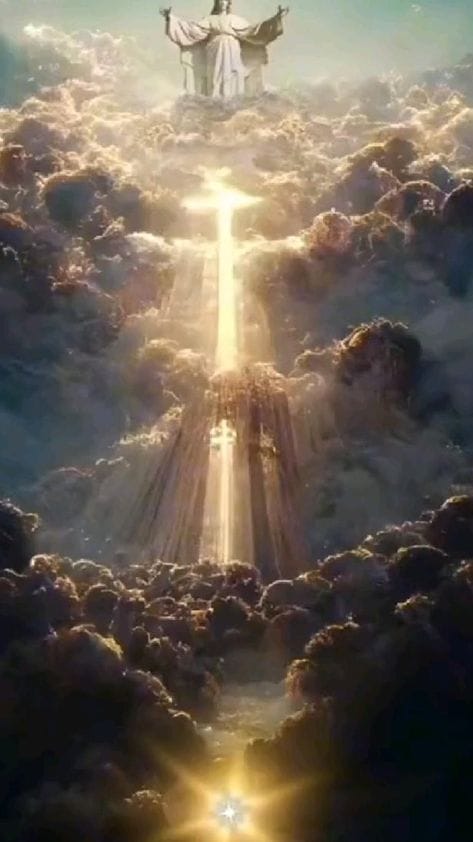
A future life in the presence of Christ may come at death when a person’s intelligent spirit immediately goes to be with Him. Or, it may come during the Rapture when the believers find themselves suspended not on water but in the air. Jesus gives a command and pulls His followers up out of this turbulent sea of humanity currently drowning in sin, and up into the safety of Heaven. Christ, through the power of the Holy Spirit, will also literally draw up the bodies of followers long dead, and restore these body back to life as He did to His own corpse in His own grave (John 10:18).
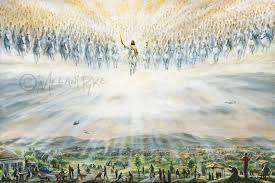
This event is also synonymous with the raptured being returned to Earth once the storms of the Great Tribulation Period are over. The disciples were rescued from the tribulations of the storm and taken back home to safety. At the Second Coming of Christ, believers will follow Jesus down from Heaven and back home to the Earth where they will live for the next one thousand years in peace (Revelation 19:11, 14; Revelation 20:6). Again, this promise from Christ should help a believer keep the worries of this world in perspective. We are to care but not be overcome. We are in this world but not of this world. This life is a training period in order to prepare us to govern with Christ in the endless Ages to come.
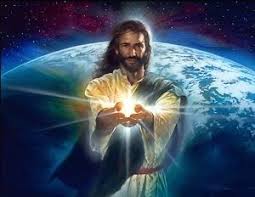
Therefore, believers can truly say, “O death, where now is your sting?” O grave, where now is your victory?" (I Corinthians 15: 55-57). Or perhaps, "For God {the Father} so loved the world {of mankind} that He gave {sacrificed} His only begotten {biological} Son {Jesus the Word} that whoever believes {has faith} in Him, will never perish {death, grave, Hell}, but {instead} have everlasting {immortal} life {throughout the Ages to come}”(John 3:16).
Amen and Amen!
If you enjoy the information provided on this site, please consider making a donation of any amount to help continue its production. Donate Now